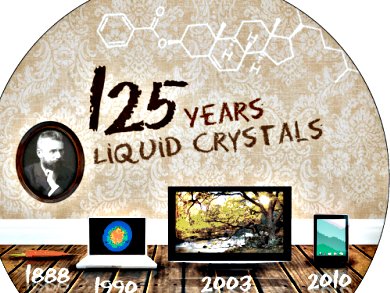Hardly any other high-tech material has become so widespread so quickly as liquid crystals. However, things developed slowly after their discovery in 1888. The German biologist Friedrich Reinitzer found a milky liquid phase between the two melting points for cholesteryl benzoate. Above the second melting point the phase was clear. Under the polarizing microscope he observed distinct violet and blue color phenomena at both phase transitions.
Having made similar observations with cholesteryl acetate, which has a monotropic cholesteric phase, he contacted the German physicist Otto Lehmann to investigate more precisely.
Discussing the results of Lehmann’s work at the annual convention of the German Bunsen Society (DBG) in 1905, the physical chemists concluded that liquid crystals cannot exist. In 1919 Ernst Haeckel still was convinced that liquid crystals are “living crystals”.
It took till 1927, that the behavior of liquid crystals, in particular their orientation in fields, was described by the Russian physicist Vsevolod Konstantinovich Freedericksz. In 1991 the French solid-state physicist Pierre-Gilles de Gennes received the Nobel Prize in Physics for his work on a full description of the free energy of liquid crystals through introduction of the order parameter tensor in the Landau–de-Gennes theory. This also explained the phase transitions.
The first application was seen in 1958. The US James Fergason used cholesteric liquid crystals for temperature indication. In 1973 liquid crystal displays were first used in pocket calculators produced by Sharp. As the p-azoxybenzenes used absorbed in visible light and had to be protected by a filter, they had characteristic yellowish displays.
The breakthrough in the use of liquid crystals came with the success of using LCDs in notebook PCs. Initially in monochrome but very soon in color, the supertwisted nematic (STN) displays prevailed in the first half of the 1990s. In the mid-1990s, the advent of in-plane switching (IPS) LCDs, vertical alignment (VA) LCDs, and normal twisted nematic thin-film-transistor (TN TFT) LCDs brought on flat screens as alternatives to cathode ray tube (CRT) monitors for desktop PCs. In less than 10 years, the era of the CRT was over. This led to a massive increase in demand for liquid crystals with negative dielectric anisotropy. Because of the patent situation, only Merck was allowed to produce them for many years.
 125 Years of Liquid Crystals—A Scientific Revolution in the Home,
125 Years of Liquid Crystals—A Scientific Revolution in the Home,
Thomas Geelhaar, Klaus Griesar, Bernd Reckmann,
Angew. Chem. Int. Ed. 2013, 52, 8798–8809.
DOI: 10.1002/anie.201301457
The whole issue 2013–52/34 of Angewandte Chemie focusses on 125 years of liquid crystals.



